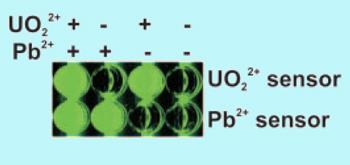High sensitivity and selectivity claimed for a portable sensor that detects most common form of uranium.
A portable sensor for the most common form of uranium could give conventional lab-based analytical methods a run for their money, predict US researchers. Yi Lu and co-workers at the University of Illinois at Urbana-Champaign, US have developed a DNA-based detector for the uranyl cation (UO22+) that offers part-per-trillion sensitivity, good enough to detect the US Environmental Protection Agency’s maximum limit for uranium in drinking water. The new sensor also showed one million-fold selectivity for uranyl over thorium(IV), which is nearly always found with uranyl. Distinguishing between these chemically and physically similar actinides using conventional atomic emission methods can be problematic, Lu reports in the Proceedings of the National Academy of Sciences this week.1

The device is based on a catalytic DNA sequence. One end is labelled with a fluorescent tag which is quenched by a group at the other end. Uranyl binds very strongly to the DNA and causes the chain to break in two, releasing the free fluorescent signaller. Lu admits he didn’t know what a uranyl sensor would look like when he set out on the project. His group used combinatorial methods to screen millions of DNA sequences for uranyl recognition before hitting on the one that worked best. The full 3D structure of the DNA has not been solved but this doesn’t worry Lu, as the sensor performs so well. If it can be identified, however, the device could be improved using smaller molecules, Lu told Chemistry World.
’To detect uranium at parts per trillion is fantastic’, said Vala Ragnarsdottir, professor of environmental sustainability at the University of Bristol, UK. The speed of measurement and portability of the device are impressive, she added. Ragnarsdottir remained cautious, however, as the ubiquitous background uranium in rocks and soil (typically part-per-million levels) may make analysis difficult. The technique might be better suited to measurement of biological samples in the field, for instance human blood samples from areas in which depleted uranium munitions have been used, she said.
So many DNA sequences can be screened that Lu believes this method could provide a general platform for sensing many other metals. ’I’m very excited about this’ said Lu, who has already prepared a solid state sensor for Pb2+ using the same methods.2 He anticipates that environmental scientists could be using this technology ’within two or three years’ but first it must be developed into a more user-friendly kit and tested rigorously in the field.
Tom Westgate
References
1 J Liu et alProc. Natl. Acad. Sci. USA,122, 10466






No comments yet